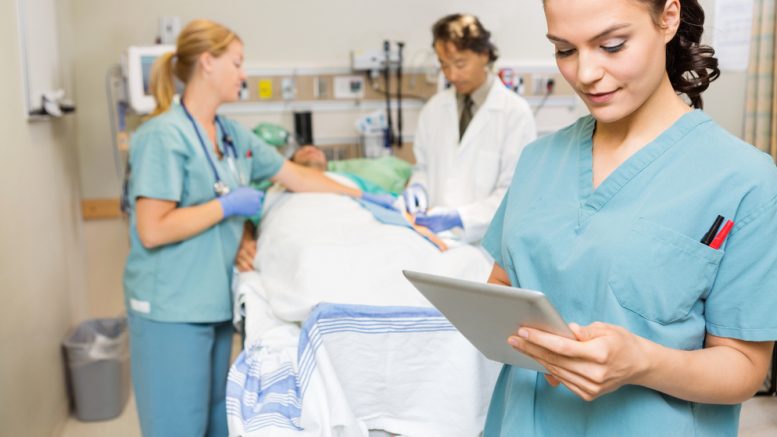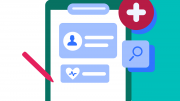Increasingly, as technology permeates every aspect of our daily lives, using technology in health provision and care coordination is becoming a core skill needed across the nursing profession.
Nurses work in the role of communication director and care coordinator for patients across many settings. This demands a diverse skill set in order to ensure optimum delivery of services.
Nurse shortages & technology advancements to improve patient care
With an ongoing nurse shortage in many countries and around the world, the need to implement technology to support nursing activities is becoming increasingly necessary in order to keep pace with the demands on health services. Innovations can relieve some of the burden when it comes to many repetitive tasks and help nurses manage numerous time-consuming responsibilities.
How healthcare technology is being used by nurses
Technology is beginning to support nurses to offer better care. It offers huge potential to clinicians, including community nurses, who deliver care across the continuum of hospital wards, people’s homes, specialist clinics, and in GP practices.
Healthcare settings now utilise a wide variety of things such as: electronic records, medication prescribing tools, tele-health, online appointment scheduling and mobile laboratories. Nurses are all too often the key personnel required to operate these solutions and maintain the associated data records.
These are some of the reasons why nursing leaders must take steps to embed digital literacy firmly in education, and across all parts of workforce and performance development.
Technology-led services are continually changing the way nurses operate. One significant factor has been the transition to electronic records. Integrated care records, that draw together accurate patient information, help nurses ensure that the needs of patients are understood. They also safeguard patients by accurately tracking progression throughout various care pathways, and allow test results, diagnoses, procedures, and treatments to be appropriately recorded in order to enhance the quality of patient care. A well designed patient record system can facilitate an easier, faster flow of information that is needed for efficient care provision.
Nurses role in patient-safety
Nurses play an essential role in ensuring the safety of patients throughout their interactions with different health services, and this ability to access and apply real-time data insights is absolutely essential in order to ensure optimum patient safety.
In the past, nurses would spend a significant amount of time trying to connect all these disparate elements of information at the bedside. Now, more and more medical institutions are in the process of ehr implementation. For clinicians, with access to connected and integrated records, it becomes much easier to optimise many of these processes.
While many care record systems are far from perfect, these new methods of working do streamline many administrative processes, involved with nursing, freeing up more time for them to actively interact with patients. They can also be critical in helping to reduce risk and mitigate hospital negligence claims.
Electronic systems and effective care provision
The introduction of electronic patient records, and integrated care processes, ensures efficient communication between clinicians, and has a direct impact on patient care processes. At the heart of modern nursing is the ability to diligently document patient information in order to coordinate effective care provision. Therefore there is a growing need for nurses to be proficient in managing the effective flow of documentation across the different systems of the care environment.
Technology is also improving standards, and quality of care, in nursing, through the delivery of evidence-based practice and support for clinical decision making. Many healthcare providers have now adopted technologies that provide data-enabled, clinical decision-making and support evidence-based nursing practice. For nurses, this helps to standardise the delivery of care within their organisations, and beyond to the wider profession, resulting in improvements to quality of care for the complete health continuum. These solutions also help reduce clinical errors and administrative delays that can impact the overall quality of care provided.
Communication across healthcare settings for patient-centred care
Communication across healthcare settings is increasingly being facilitated by instant messaging and team collaboration tools that facilitate multi-disciplinary teams. For nurses, who usually provide the lynchpin services of these teams, this means coordinating care is becoming more streamlined and thus more efficient. Point-of-care testing, and access to bedside test results, reduces the time taken to identify, and diagnose, while improved scheduling software enables staff to maintain standards of care across hand-overs and between departments.
Healthcare outcomes, including quality of life measures, are the result of a multifaceted relationship between the patient, the nurse, and the treatment and the healthcare system. Adopting the right technologies within practice is a continually evolving process that relies on the skills of today’s modern nurses to achieve an appropriate balance.
With a rapidly ageing population, changes in technology, changes in management demands, and the evolution of nursing knowledge and practice, have created growing opportunities for qualified senior nurses and nurse leaders. If you’re interested in furthering your nursing career, and stepping into a leadership role, find out more.
- https://www.himss.org/right-balance-technology-and-patient-care





